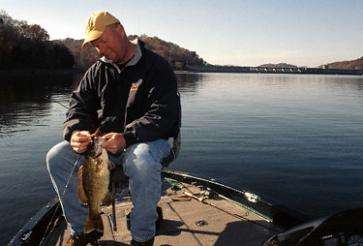
It’s early January, and the fish are acting a little strange. OK, maybe not strange as much as different from most other years. Some anglers are having trouble catching them. That’s mostly because they’re looking in the wrong places and at the wrong depth.
In most years, by now the bigger smallies are out in (or near) the main lake, suspended over deep water near points and bluff walls. That’s float-and-fly fishing at its best. This year, because of all the rain, snow and high water, they’re still in the creeks off the second and third points and they’re hanging near the bottom, not up in the water column as usual.
A lot of guys are catching them on tailspinners. They’ve been biting real good when the tailspinner is slow rolled just off the bottom. The guys catching most of the fish have been letting their baits fall all the way down and then pulling them up and winding them straight back towards the boat. Nothing fancy, just a steady slow roll a few inches off the bottom.
Punisher Lures makes a tailspinner, The Little Sparkie, that’s perfect for this. It’s got a narrower head than most tailspinners, like the Mann’s Little George, so it’s easier to keep down near the bottom. The wire on the back is longer, too, so the blade turns more easily at slower speeds.
Those things make a big difference. If you’re going to fish one, I suggest you use fluorocarbon line. It’ll help keep the lure down near the bottom, where it needs to be if it’s going to catch bass. I’m getting reports, though, that some guys are breaking off a lot of fish when they use fluorocarbon. It’s almost certainly because they don’t set their drag right.
Fluorocarbon doesn’t stretch like monofilament. That means that when a big smallmouth slams your lure, there’s a terrible jolt to the line. Smallmouth bass aren’t largemouth bass. They hit like a freight train. They’ll snap fluorocarbon line in a second if you don’t have your drag set right.
I set mine by making sure it’s looser than if I was using the same size monofilament. That lets the line slip which compensates for the lack of stretch. It’ll take you some time to get used to it. That’s for sure. At first it’ll seem like it’s too loose and sloppy. You won’t trust it. But, after a while, you’ll see how it works and wonder why you didn’t do it years ago.
That’s the funny thing about fishing. We all learn everyday from other anglers. But what we learn seems obvious once someone shows us. You’d think we’d think of a lot of this stuff ourselves, but we don’t. I guess that’s what makes this sport so great, especially smallmouth fishing. If we all pull together, we can catch a few more! Until next time, if you have any questions or comments, I’d love to hear from you. Please e-mail me at Stephen@thesmallmouthguru.com





